| 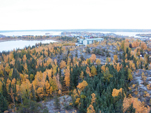 | 1: Delayed Start
Today was not originally going to be our first day aboard ship. The plan was to board last Friday, in Kugluktuk. Unfortunately, rain there caused flooding on the airstrip, closing the airport, so we had to reroute through Cambridge Bay after a couple of extra days in Yellowknife. This turned out to not be so bad, because Yellowknife in September is picturesque. The leaves were in their fall colors, and, although it rained on Friday afternoon, the weather was generally pleasant. In anticipation of being mostly ship-bound for the next three weeks or so, lots of walking was in order. The view from the Pilot’s Monument, on a rocky hill in Old Town Yellowknife, made for a nice destination. This was also reported to have been a good spot to watch the beautiful northern lights that appeared on Thursday and Saturday nights. | 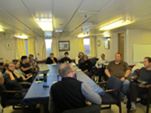 | 2: The Unpacking Continues
Canadian Vickers Ltd built the C. C. G. S. Louis S. St-Laurent, or the Louis, in 1969. Although she is now used primarily as a platform for Arctic research, this was not always the case. For many years, the Louis patrolled waters in the Arctic Ocean and the Gulf of St. Lawrence, maintaining the shipping lanes there. The biggest of all the Canadian icebreakers at 119.63 meters, she’s had an illustrious career. On her first voyage, she accompanied the first tanker to ever take the Northwest Passage. More recently, along with a U.S. coast guard icebreaker (the imaginatively named U.S.C.G.C. Polar Sea), the Louis was the first surface vessel to traverse the Arctic Ocean (going from the Atlantic to the Pacific) via the North Pole. This was in 1994, and the Institute of Ocean Science’s Eddy Carmack was the Canadian Science Coordinator on board at the time. The Louis is also somewhat of a pop culture icon. Not only did she have a part in Hollywood blockbuster The Titanic alongside Leonardo DiCaprio, but also the popular CBC news show The National was broadcast nightly from her hallowed decks in 2006 for a full week. All in all, she’s quite the ship. | 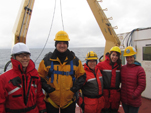 | 3: Let the Science Begin!
Today officially marked the start of scientific data collection onboard ship. Anticipating a mid-morning arrival at the station where we would undertake our first (and second) CTD/rosette casts, we awoke to a stiff, cold, wind, and flurries of snow. Seemingly foreboding conditions until you remember you’re in the Arctic, and the fact that temperatures are hovering a couple of degrees above freezing means you’re actually getting lucky with the weather. So we threw on some layers, our inflatable suits, our gloves and our hardhats, and prepared to cast a CTD/rosette! (I wish there was a catchier name than ‘CTD/rosette’, but to the best of my knowledge there just isn’t.) | 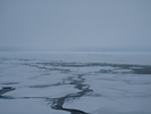 | 4: Into the Ice
Because it is an icebreaking ship, the Louis is designed to have a rounded hull. This feature enables it to ride up on ice floes in its path and crush down through them using gravity. All well and good when you’re breaking ice, but the flip side of the rounded hull is that it increases the rolling response of the boat to even small amounts of swell when in open water, as we have been the past three days. I can’t say for sure, but I think I woke up almost instantly when we first hit ice around 5 AM this morning. Not only did the motion of the ship change completely (going from the familiar mellow side-to-side roll, to a jerky stop and start, with lengthwise vertical motion thrown in, like a teeter totter) but also the sound was unmistakable, not to mention — particularly for those with cabins closer to the bow of the boat, like Sam Thomas — deafening. | 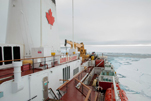 | 5: The Icescape and a Boat-building Competition
Now that we’re into the icepack, the air has been getting noticeably colder. During a CTD/rosette cast this evening, the outdoor thermometer read -5 degrees Celsius, but the breeze blowing off the water and ice added quite a bite. The number of layers I put on before going outside has been increasing rapidly—if the current trend continues, I’ll be wearing my long underwear tomorrow beneath pants, a shirt and sweater, insulated coveralls, and a Mustang jacket, along with a balaclava and my largest pair of mittens. My wardrobe can’t sustain this trend for long, though, so here’s hoping I packed enough warm clothing for when/if the thermometer starts to really drop, a strong likelihood in the coming weeks as winter descends over the Arctic. Fortunately for me, all of the experienced members of the science crew seem to have packed duplicates of everything important, so if my own gear falls short, I won’t be forced to spend the long CTD/rosette watches shivering madly, huddling for warmth against the air vents on deck, dreaming of more temperate climes. | 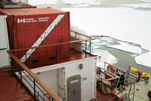 | 6: The First Mooring Recovery
If, over the first five days of the cruise, anyone managed to fall into a routine, they were probably shaken out of it today when the group from WHOI—Rick Krishfield, John Kemp, Jeff O’Brien, and Meghan Donohue, along with Cory Beatty of the University of Montana—took over the ship to recover a several-thousand-meter-long array of oceanographic instruments called a ‘mooring’. This particular mooring had been sitting out here at station BGOS-D, anchored to the bottom of the central Beaufort Sea, since it was deployed last August. Needless to say, it seemed glad to have us stop by and haul it up for a bit of fresh air. | 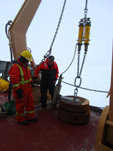 | 7: Redeployment
Today, we redeployed the mooring we had recovered yesterday at station BGOS-D (with some instrument changes). First, a bathymetric survey was done in order to choose an optimal location on the seafloor for the mooring to rest. Following that, just after lunch, the mooring started going overboard. It was a cold day, with strong winds and flurries of snow, making it all the more impressive to watch the mooring team, led by John Kemp, working—frequently in bare hands—to make sure everything went smoothly. The final piece of the array to go overboard was the giant yellow sphere that tops off the mooring, about an hour after darkness fell, with the sounds of Karaoke from the forward lounge discernible in the background. | 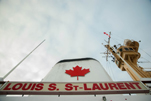 | 8: Back in Open Water
Today, with the first round of mooring work completed, the main focus of the scientific activity aboard ship returned to CTD/rosette casts. We’ve traveled back south since leaving mooring station BGOS-D, across the southern edge of the icepack, and are in ice-free waters for the time being. Without the threat of ice chunks, the casts were uneventful—exactly how you want them to be. | 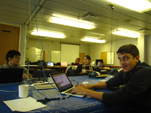 | 9: A Fairly Normal Day
First, an addendum to yesterday’s dispatch. I forgot to mention the ceremony that took place yesterday evening in the front lounge, where Captain Marc Rothwell bestowed certificates of achievement on all us Arctic Greenhorns. Apparently these certificates are important, like passports to the Beaufort Sea: if and when we return, we were told to make sure we bring the certificate to prove our experienced status and avoid repeating the trials and tribulations (e.g., participating in a talent show) that we have just survived. This will be difficult for me, as I’ve already made plans to frame my certificate and give it a place of honor on my bedroom wall. | 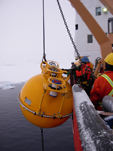 | 10: A Day of Recovery
Lots to write about after a busy day of pulling instruments out of the ice. I’ll get right to it. | 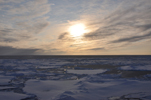 | 11: Day Eleven
We returned during the night (after a trip out to station CB-7 for a CTD/rosette cast plus detours for buoys) to station BGOS-A to replace the mooring we had recovered yesterday. The new mooring had a couple of instruments going down with it that I hadn’t seen before, including the TUMSAT device I mentioned yesterday, an RAS-500 (RAS stands for Remote Access Sampler). The RAS-500 is battery-powered and autonomously samples the water at the depth where it is tethered along the mooring array, about 35 meters below the ocean surface. It will collect a total of 48 samples over the course of the next year, which works out to one sample every 8 days. The instrument belongs to Michiyo Yamamoto-Kawai, an oceanographer at TUMSAT. She’ll run a suite of tests on the samples similar to those done on water from rosette casts, giving her a window into water properties during winter months when the rosette casts aren’t possible. The other new instrument, for measuring water pH, comes from Mike Degrandpre of the University of Montana. Data from both will contribute to the broad goal of understanding ocean acidification and its effects in the Arctic. | 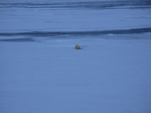 | 12: A (Not So) Sinking Feeling
We barely needed to deviate from our course this morning to pick up ITP 77 en route from station BGOS-A to station TU-1. (A brief aside on these station names: don’t read too much into them. Early on, I tried to understand the significance of one station carrying the prefix CB, while another was BGOS or TU or something else entirely. Often, they refer to the institution or project that selected them, but there’s no real relevance, as far as I can tell, to the nomenclature. Indeed, Chief Scientist Bill Williams told me that he once named stations random letters, expecting to be asked about it by other scientists. No one ever questioned him.) Anyways, ITP 77 had the same programming bug as ITP 79, and not only that, but the shelf waters the ITP was traveling over were shallow enough that the cable was actually dragging over the seafloor creating a risk that the instruments might be damaged or even lost during a deep profile. Luckily, when we found the ITP, the profiler was near the surface and unharmed. Getting these ITPs back safely is very important. The programming bug prevented them from relaying any of the oceanographic data they were collecting, but that data (nearly 700 profiles) was still stored on the ITP. Considering the investment that goes into deploying these devices, recovering that stored data is imperative. | 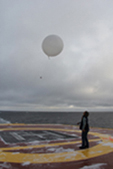 | 13: Radiosondes and Pictures of Ice
After a short trip south during the night for some XCTD work, we returned to TU-1 in the early AM today so that the TUMSAT mooring could be recovered, moved to the right water depth, and redeployed. It was nice to see it disappear this time around. With that out of the way, we set a course for TU-2, about a hundred and fifty nautical miles to the northwest. Lying almost due north of Bering Strait over the Chukchi Abyssal Plain, TU-2 will be the westernmost station of our cruise. Interesting bathymetric features along the way: another abyssal plain, aptly named ‘Northwinds’, and the Chukchi Plateau. Up until yesterday, we’ve spent most of our time above the Canada Abyssal Plain, so it’s exciting to encounter some new terrain—even if we can’t see it. | 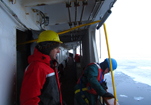 | 14: Working on the Weekend
Another TUMSAT mooring went down this morning here at station TU-2, westernmost of the cruise. This was one of the colder deployments so far. Good preparation for the on-ice stations coming up on the horizon. Once it was over, ships’ engines fired up for the 200-nautical mile trip back north and east across the Chukchi Plateau to the northern tip of the Northwinds Ridge and station CB-10, with an ETA of sometime on the afternoon of the following day (our speed varies depending on the thickness of the ice we are passing through, so it’s difficult to precisely predict when we will arrive somewhere). Travel time is nice for everyone; it lets people catch up on the backlog of samples needing processing, prepare instruments for deployment, or just kick back and play a game of crib. For me, it meant a chance to spend some time talking to Pat Kelly about the research that’s brought him and Brice Loose all the way to the Arctic from the University of Rhode Island. | 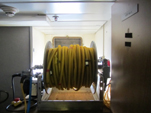 | 15: More on Brice and Pat
Today, like the past three days, was spent mainly in transit. We arrived at station CB-10 for a quick post-supper CTD/rosette cast, then continued on to CB-11 (where we’ll have our first ice station) immediately afterwards. The going is slow now that we’re into heavy ice cover. Thick ridges formed by floes battering against each other are common, and the Louis has to make frequent use of its bubblers to create a fizzy layer of water between the hull and the ice and ease its passage. Sometimes forward progress is impossible, so the ship has to back up and take repeated runs at the pack to break through, or find an alternative route. Noise levels below decks are higher than ever. On multiple occasions I’ve seriously wondered, after particularly loud battering and ramming sequences, whether the hull had been breached, leaving me moments from an icy grave. In general, though, I’m happy to see the more substantial ice, knowing that we’ll be walking around on it sometime tomorrow. |  | 16: Onto the Ice
I actually woke up in time for breakfast this morning for the first time since our first full day on the Louis. (In my defense, my CTD watch ends at midnight and breakfast is served at seven-thirty.) I had a good reason for breaking my civilized routine: today was our first ice station, and I definitely did not want to miss my helicopter flight out onto the ice. | 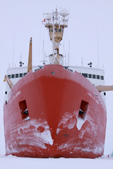 | 17: First Glimpse of the Maritime Bear
People had just had their plates filled and seated themselves for a meal of chicken wings and pasta in the mess last night when, at long last, the announcement we’d all been hoping to hear finally came over the intercom: “A polar bear has been spotted from the bridge”. Chairs were thrown back like caution to the wind and it’s a miracle no one was trampled in the stampede to retrieve cameras and make it onto the foredeck to catch a glimpse of the beast before it melted back into the frozen wasteland. | 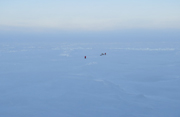 | 18: How to Deploy an ITP
Why not start off this dispatch with some good news? Today, Bill Williams told me that the Louis is the only ship in the western Arctic Ocean right now—all of the other icebreakers have headed for port or more temperate waters. That’s reassuring, because Bill also said that we are currently stuck in between two big pressure systems up here at the top of the world, one high and one low, and are therefore expecting gale-force winds in the next couple of days. At least rough seas won’t be an issue: according to satellite imagery, we’ll be slogging through thick, multi-year ice from now until we leave the Beaufort Sea at the end of the cruise. | 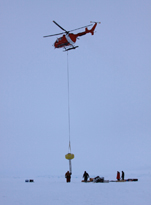 | 19: O-Buoys
Every now and then, when I’m wandering lost in the catacomb of indistinguishable passageways deep within the Louis, I’ll stumble across some forgotten corner and hear strains of an Appalachian folk tune whispering in and out of the dull roar of diesel engines and crack of relentless steel against Arctic ice. Then I’ll know that Wes Halfacre is somewhere nearby, strumming a lonesome chord on his banjo and pining for the bluegrass hills of his youth. | 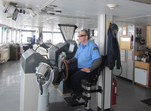 | 20: Finding Your Way in Ice
As I mentioned in a recent dispatch, during this latter portion of the cruise we have been traveling through consistently thick, multi-year ice—conditions the Louis was built to handle. But just because she was built for it doesn’t mean she likes doing it. Crunching through heavy ice is tedious and requires a lot of power, and can occasionally be fruitless. It’s faster and more fuel-efficient to follow leads in the ice. And even if there’s no open water to be found, there are usually weak spots or cracks to be exploited. At the very least, whoever’s navigating the ship will do their best to avoid the meters-thick ridges created by floes rafting together. | 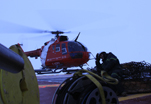 | 21: Ice Station, Round 2
A group of us left the comfort and safety of the Louis’ decks and took to the ice today to set up the second and last Ice Based Observatory of the cruise at station PP-7, 180-odd nautical miles west of Prince Patrick Island. Unlike the last, this ice station went smoothly. It helped that we had ideal weather (for this time of year)—mild temperatures, light winds, and just enough snow falling to set the mood. Visibility in the morning was good, and Rick Krishfield and John Kemp were able to get out in the helicopter for a recon flight right after breakfast. They checked out a large floe directly starboard of the ship and quickly deemed it fit for work. Anyone deploying one of the IBO buoys was flown out immediately with their gear so they could get started. The rest of us waited while Captain Marc Rothwell and Chief Officer Rod Strowbridge considered lowering the gangway, which they eventually decided against because the ice alongside the ship was too broken up to be safe. Instead, helicopter pilot Chris Swannell shuttled the rest of the ice-goers out over the next half-hour. | 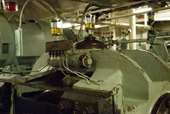 | 22: Engines and Lemon Ice
Now that the ice stations are wrapped up and the moorings are all deployed, science-related activities on the Louis are slowing down and everything is a little more relaxed. Sarah Zimmerman, Caroline Wylie, Cory Beatty, Brice Loose and I even had a chance to sneak down to the engine room today with Chief Engineer Danny Parmiter for a look around. | 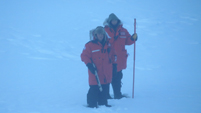 | 23: Photo Retrospective
Things are winding down onboard ship. There are only a few stations left to hit, and we expect to finish the last one sometime tomorrow evening. For today’s dispatch, I think I’ll cut down on the writing and let a selection of photos from earlier in the cruise do the talking | 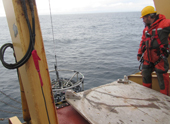 | 24: The Last Cast
This dispatch, mainly photos, is in commemoration of our final CTD/rosette cast of the cruise, taking place later this evening. CTD/rosettes are the bread and butter of oceanographic observation, standard fare for a research cruise. Including tonight’s, we did a total of forty over the course of this trip; some shallow, some deep, some cold, others colder. I’ll admit that I complained once or twice about having to stand on deck at 11 PM to watch a cable disappear off a winch and into black water for an hour (although I had it easy compared to the night watch folks, who did the same thing at 3 AM), or squat in a chilly shack like a farmer milking -1.9 °C water into tiny glass vials with frozen fingers. Overall, though, it was neat to be on the front lines of oceanographic data collection, taking samples that will one day become points on fancy plots (if they haven’t already—lots of data processing took place on board) to further humanity’s knowledge of the earth we inhabit. | 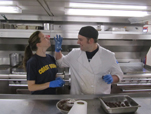 | 25: Halloween Party
Packing is everyone’s main focus as we steam back to Kugluktuk, but people set down their inventory lists and tote boxes for a few hours this evening to attend the farewell/Halloween party put on by the galley. Tasty snacks and creative costumes set the scene for the highlight of the night: the pumpkin-carving contest. The engineering team’s headless figure narrowly beat the ‘miscellaneous’ team’s helicopter, with the navigation team’s terrifyingly realistic anglerfish pumpkin coming in third. | 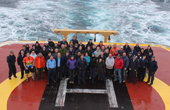 | 26: A Final Word from the Chief Scientist
I’d like to say a big thank-you for the big effort this year from the science team and from the Captain and crew of the CCGS Louis S. St-Laurent. The mission is successful and well done, and done in the face of winter freeze-up and rapidly shortening daylight hours. | 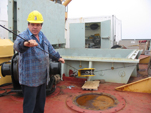 | 27: In Memory of Peter King
As the science party departs at the conclusion of the cruise, the excitement of heading home is tempered by the melancholy of departing from the wonderful relationships that developed between the science party and with the officers and crew of the Louis over the past 4 weeks. Some of us are already looking forward to next year's expedition, and others of us are remembering those that we've sailed with on past expeditions. |
Last updated: October 7, 2019 |





























